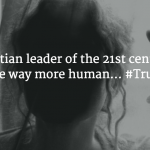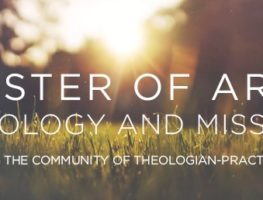Near the cross of Jesus stood his mother, his mother’s sister, Mary the wife of Clopas, and Mary Magdalene. When Jesus saw his mother there, and the disciple whom he loved standing nearby, he said to her, ‘Woman, here is your son,’ and to the disciple, ‘Here is your mother.’ From that time on, this disciple took her into his home. {John 19:25-27}
My conclusion from this small snippet of Christ’s death is that if it’s truly the cross, it will ultimately bring together the oddest of people. A community of paradox. In our text, standing around Jesus at his death are Mary, Mary’s sister, Mary wife of Clopas, and Mary Magdalene. There are lots of Mary’s. Alongside the women is a whole squadron of Roman soldiers. And of course, John, the disciple, whom “Jesus loves.” (v. 26) Finally, there were the criminals, one on each side, who die with Jesus. What a community, who is left to see the Messiah, God incarnate, die?
Incidentally, Jesus and Socrates had one thing in common: neither wrote anything down. That means that all we know about what either of them said comes from one source: the groupies they’d gathered. It wasn’t hard to gather a group of listeners back then. In fact, around the time of Jesus there were thirteen recorded self-claimed Messiah’s. In such a tumultuous time, people were willing to listen to anyone. No one was really getting along, kind of like today. Yet, as a Messiah, Jesus was unique in that he created community even in his death.
During his life, Jesus brought enemies together for a common goal. Sadducees and Pharisees, for instance, found one thing they agreed upon: Jesus’ death. Like Christians, in Jesus’ death, the Pharisees and Sadducees found something in common. As well, Jesus called Simon the tax collector and Simon the zealot; two people clearly of differing political agendas. Which leads to something profound. Jesus chose that truth would be passed down primarily through a community of paradox. In doing so, he did not pen books but he did author communities. Unlike other Messiah’s, these communities didn’t end when Jesus did. This set him apart as different from others who claimed to be Messiah. In John 21, what are the disciples doing after Jesus resurrects? They’re fishing together. Some people make that about going back to their former assignments, but I think its about the fact that they are still hanging out together.
Jesus created “divergent community.” A divergent community that was centered on the unity of a little that made room for diversity in the many.
Jesus did not stop creating community at his death. Later, when the Holy Spirit descends on the church at Pentecost, what Jürgen Moltmann calls the “Birthday of the church” or the day the church went viral, community is being created. You will notice in the text of Acts 2 that a number of groups watching are represented. They stand in awe of the church’s birth. And quietly you see “Arabs and Cretans” mentioned together. Two groups are known in history to have hated each other vehemently. To be clear, we must establish that the Jesus and his cross create a community of paradox. Even to the degree that opposites are thrown together.
This is the nature of truth for Christianity. The church has always been built on the foundation of what we call paradox. The Trinity, for heaven sakes, is God three and one. Jesus is fully God and human. God is incarnate and transcendent. In order to live we must die. All of this paradoxical language. We call all of it paradox. Church history will even tell us that in the early church heretics sought, not to make the truth of God more complex, rather, they sought to reduce these paradoxical truths into simpler formulations. To make them easier. To make them more culturally relevant. Ultimately, in the story of historical theology, if it makes more sense, it is often more likely to be heretical.
It is striking that in such a male-centered culture, Jesus finds the bulk of his support from women. Women witnessed his death. In the legal world, women did not have permission to witness in court. They didn’t have protections under the law. They were at the bottom of society. They could not vouch for what was seen. Yet, who was the first one to witness the resurrection?
The same women to see his death: Mary Magdalene. She is the only one who was at both the first Good Friday service and the first Easter service. In fact, as she runs to tell the disciples of Easter, she inevitably becomes the first person to preach an Easter sermon. This would mean she was one of the few people who proclaimed the risen Lord who was actually at the death scene. That would mean if people wanted to know that Jesus had actually died and resurrected, they had to talk to a woman with a really bad reputation.
I want to force myself to ask three questions about leading in reflecting upon what Jesus did masterfully in creating community around himself:
1) As a leader in the church, will people still be hang out after I leave? Will it fall apart if I do? Does the community transcend my presence?
2) Are people gathering around the cross or around agendas? Because we center it not on the cross but other little pithy things that we think community should be centered in. Do you have people who like Rob Bell and people who like Mark Driscoll worshipping together in the same place? Can people who speak in tongues find fellowship with those who don’t?
3) Is there room for my enemies at the cross? Can those whom I’ve had a battle with find Christ there too? Or is the cross only safe for my political and theological friends?





Missio Alliance Comment Policy
The Missio Alliance Writing Collectives exist as a ministry of writing to resource theological practitioners for mission. From our Leading Voices to our regular Writing Team and those invited to publish with us as Community Voices, we are creating a space for thoughtful engagement of critical issues and questions facing the North American Church in God’s mission. This sort of thoughtful engagement is something that we seek to engender not only in our publishing, but in conversations that unfold as a result in the comment section of our articles.
Unfortunately, because of the relational distance introduced by online communication, “thoughtful engagement” and “comment sections” seldom go hand in hand. At the same time, censorship of comments by those who disagree with points made by authors, whose anger or limited perspective taints their words, or who simply feel the need to express their own opinion on a topic without any meaningful engagement with the article or comment in question can mask an important window into the true state of Christian discourse. As such, Missio Alliance sets forth the following suggestions for those who wish to engage in conversation around our writing:
1. Seek to understand the author’s intent.
If you disagree with something the an author said, consider framing your response as, “I hear you as saying _________. Am I understanding you correctly? If so, here’s why I disagree. _____________.
2. Seek to make your own voice heard.
We deeply desire and value the voice and perspective of our readers. However you may react to an article we publish or a fellow commenter, we encourage you to set forth that reaction is the most constructive way possible. Use your voice and perspective to move conversation forward rather than shut it down.
3. Share your story.
One of our favorite tenants is that “an enemy is someone whose story we haven’t heard.” Very often disagreements and rants are the result of people talking past rather than to one another. Everyone’s perspective is intimately bound up with their own stories – their contexts and experiences. We encourage you to couch your comments in whatever aspect of your own story might help others understand where you are coming from.
In view of those suggestions for shaping conversation on our site and in an effort to curate a hospitable space of open conversation, Missio Alliance may delete comments and/or ban users who show no regard for constructive engagement, especially those whose comments are easily construed as trolling, threatening, or abusive.